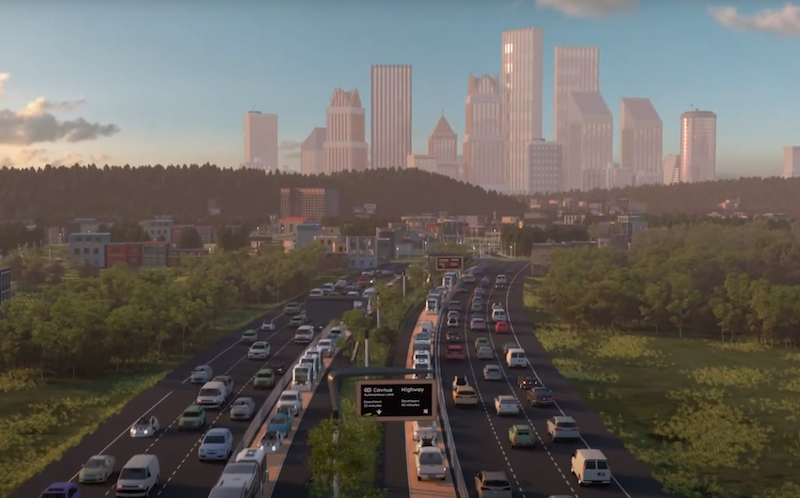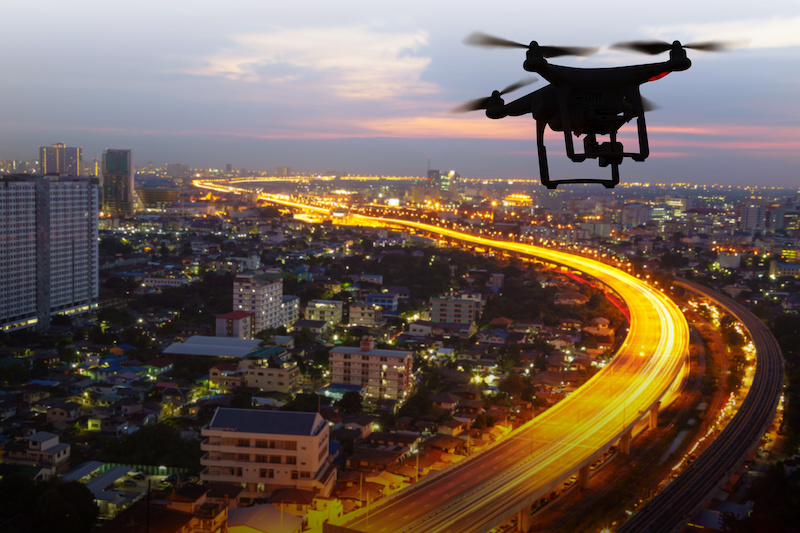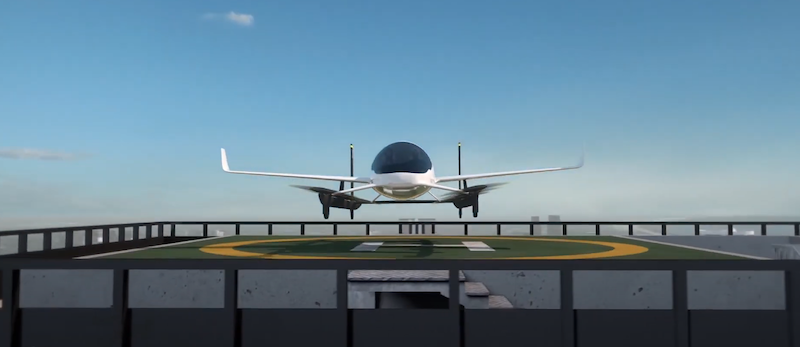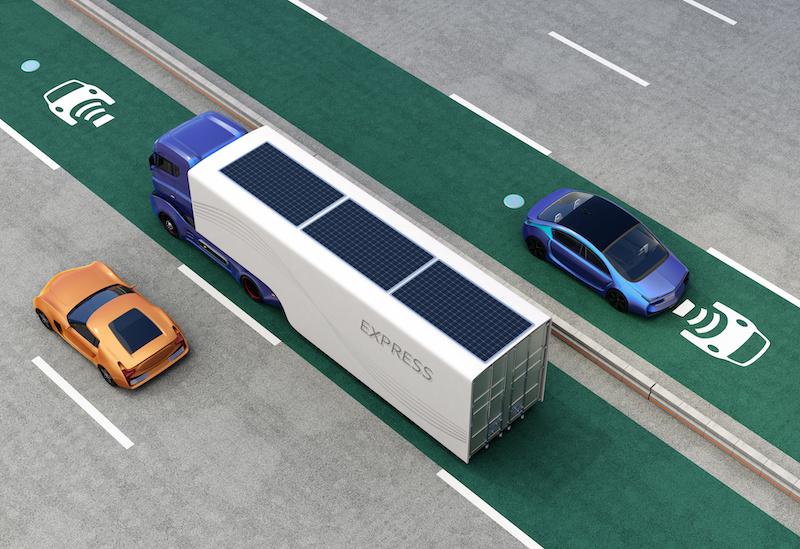
‘We wrote the playbook’: Michigan reinvents itself as the global capital of autonomous mobility
The US state of Michigan is reinventing itself as the global capital of autonomous mobility. From opening an air corridor for drones to building a stretch of road on which electric vehicles can charge themselves wirelessly as they move along, the state is creating an ecosystem which could become something of a template for the rest of America.
Michigan is, as most readers will know, the state in which Detroit is located. Detroit, the most populous city in the state, is the historic centre of the modern global automotive industry, or “Motor Town” as it was famously called many decades ago, inspiring the name “Motown” for the even more famous record label.
And while it may have lost some of its industrial status in recent decades, Detroit still provides homes and office space to some of the largest automotive companies in the world: Ford, General Motors, Mercedes-Benz USA, Fiat Chrysler Automobiles, and a whole range of automotive components, systems and parts manufacturers.
It is this manufacturing base, this advanced technological know-how – as well as the scenic landscape and extensive road networks – that the local government is looking to tap into as it invites startups from around the world to look at the opportunities the state provides.
In this interview, Robotics and Automation News speaks with two senior executives from the Michigan Economic Development Corporation, an agency of the state government.
- Trevor Pawl, chief mobility officer; and
- Charlie Tyson, technology activation manager.

Local government can be bureaucratic, but the two executives appear to be highly motivated to hear from companies and organisations that want to join Michigan on its journey towards a new world of electrified and autonomous transportation which will simultaneously bring economic and environmental benefits to the region.
The interview was conducted by Abdul Montaqim and took place about a week ago, and can be viewed on our YouTube channel.
Abdul Montaqim: Please give us a brief overview of your jobs.
Trever Pawl: I’m the chief mobility officer of the State of Michigan and, as part of that role, I lead the Office of Future Mobility and Electrification, which focuses on the future of transportation as it relates to automotive but also other modes of transportation.
So we do a lot of work stitching together public-private partnerships, we do a lot of work building Michigan’s mobility narrative, and we do a lot of work on the policy side, making sure that we have the right regulatory frameworks in mind that would allow for not just the future of mobility to occur on ground but also other dimensions like in the air.
Charlie Tyson: My title is technology activation manager, which is is something that’s super fun and something I’m passionate about. And really what that entails is working with companies globally and locally in Michigan to understand ways to help them connect with communities here in our state, to find ways to essentially improve the quality of life related to getting people to and from medical appointments, getting goods and vital medical supplies to people that may not have access to those goods.
So everything really revolves around how we move people and goods using technology and new mobility solutions and making sure that we engage communities to do so.
AM: Can we start by providing an overview of what Michigan is doing in the area of mobility? You recently announced two projects: one is a drone corridor linking Michigan to Ontario, Canada; and the other is the inductive or wireless charging highway, on which electric vehicles can get charged by simply driving along them.
TP: Yeah, sure. So, you know, people don’t realize that the three-color traffic signal, lane markings, paved roads… like, that all came from Michigan. We did that, we wrote the playbook for it, and, ultimately, it spread all over the world.
And beyond growing our industry, building vehicles, conducting research and development on on the future of autonomous technologies, shared, connected, electric, we view our role as also driving infrastructure forward.
So we’ve tried to over the last year-and-a-half to create signature projects that can inspire other regions around the world and also make life a little better here in Michigan.
And one of those things is that we are aggressively rolling out charging stations (for electric vehicles) because we know we want to get our electric vehicle adoption numbers up.
We also wanted to lead, to try something that has never been tried before because we think that it could be the way of the future – and that’s a wireless charging corridor, where the road charges the vehicle as it’s in motion.
Right now, we’re starting it with a project in Detroit. Our partners include Electron, Ford Motor Company and Next Energy. And the goal is to to install a a mile of this technology on a public road and and where this really makes sense is if you think about transit vehicles that take the same route over and over and over again to not have to stop at a station and charge, but rather to charge while in motion – it makes a lot of sense. Same with delivery vans and other sort of vehicles that operate in a routine way.
So we’re excited about it, and hopefully the deployment goes well and we can continue to expand this this wireless charging system because we do think this is where charging is headed and we want to make sure that we’re as EV-friendly as possible by installing charging stations today, but then also thinking about tomorrow and being as friendly to innovation as we possibly can.
CT: We’re really excited about the amount of activity in wireless charging right now and how Michigan has kind of solidified its place in the global mobility market as a state that’s friendly to these types of innovations.
There’s companies left and right that are looking to engage Michigan and to deploy by working with public and private partners, so we like to be that liaison there.
As Trevor alluded to, as commercial fleet electrification increases, the sky’s the limit, if you will, when it comes to wireless charging so really excited about it
AM: These are very both forward-looking initiatives. Let’s look at the air corridor for drones first. This reminds me of a story a few years ago about Nasa having developed a kind of a theoretical framework or air traffic control system for drones (Unmanned Aircraft Systems Traffic Management). It sounds like a very complex task.
TP: I’ll start the answer, but really this is a project that Charlie is taking the lead on, so I’ll set the stage.
So the idea here is, we believe aerial mobility or drones is a mode of transportation that will be needed going forward in critical moments such as delivering medicine and consumer goods, and life-saving devices.
If someone, say, has a heart attack on a highway in the traffic jam, you can fly a drone in. Critical manufacturing parts, where something the size of a quarter breaks on a machine, which, in turn, could cost hundreds of thousands of dollars to a company (if it isn’t supplied and fixed) every 30 minutes that machine is down.
So there’s some really functional use cases.
And then when you think about all the activity at the Michigan-Ontario border. We actually have two of the top three busiest border crossings between us and Canada. We look at aerial mobility as a way to alleviate some bottlenecks and, frankly, create better experiences for those that that need goods or need to cross a border.
So we partnered with some of the best companies in the world at this stuff – telus and airspace link and ford and even the province of ontario – to begin to think about what would a commercial drone skyway look like and how do we do it responsibly.
How do we create the right policies the right technical requirements so that it’s an equitable and inclusive transportation option? And how can we roll it out in a way where you don’t walk out of your house and you hear a bunch of drones flying over? That’d be terrible. So how do we do this responsibly?
If we know this technology is coming, how do we do it responsibly?
And that’s the goal here: to create the business case, and then work with companies like Amazon and UPS and Fedex and others that are really leaning into this space, to make sure that Michigan’s a leader and can help set national standards.
CT: Trevor, you pretty much hit that nail on the head with that. I would add a little bit more around the nuts and bolts of this announcement and where Michigan’s at when it comes to drones and where we see the state being in the coming years.
So this feasibility study and engineering analysis is really key and critical for us to be able to get approval for what’s called beyond visual line of sight. It’s an approval process, it’s a certification, if you will, through the FAA in order to essentially be able to fly a drone beyond visual line of sight.
Right now, there are projects with companies deploying drones throughout the world (according to different rules). Here in Michigan, we are working with healthcare systems to move vital patient care items, medical supplies from one facility to another, within visual line of sight.
But really to unlock economic opportunities for companies, and to encourage them to come here and deploy, we need to get this approval (to fly drones beyond the line of visual sight).
To understand what the safety cases are, there are certain routes we are looking at, such as along train tracks or waterways. We also want to see how this aerial mobility corridor communicates with ground-based systems like vehicles, for example.
We have to understand what type of infrastructure is going to be required to to operate these drones in a safe and persistent manner that isn’t causing loud noises and waking people up at night.
We’ve got to do it in a way that’s not going to hinder communities and residents, but in a way that’s going to unlock significant economic development opportunities for companies, but also finding ways to do good from a social impact standpoint by getting people vital goods way quicker.
It’s something that maybe we don’t think about as much average individuals, but it’s really important for some people being able to get goods much quicker, whether it’s from a healthcare standpoint or even just groceries, for example.
So we we’re doing this in a way that is going to align with other industry partners, the FAA and also working with Nasa, as you mentioned, just to understand where they’re at, how we can leverage their expertise and collaborate as a group.
AM: What’s the distance we’re looking at of the corridor – how far is it from the Michigan place and the Ontario place?
CT: The study and the analysis will look at three different routes – essentially corridors. Two being in southeast Michigan, one looking at cross-border with Ontario, and then we are keeping it open-ended as far as the RFP (request for proposal) winners.
The companies… who are conducting this engineering analysis and study… we want them to come to us at the state with recommendations on additional corridors or routes. whether that’s west Michigan, a route in the upper peninsula in more of a rural setting.
And these routes can be from targeting around 40 to 60 miles, but as battery technology improves, and the ability to have a higher payload essentially being able to deliver packages with more weight, higher number of packages, based on improvements of battery technology, that distance will extend to 60 miles at the moment.

AM: Yes, the range of a typical drone is quite limited, I believe, but I suppose by the time this route is fully open, or the corridor is fully operational, within a few years, there will be larger drones, and other types of drones. I’m not sure if they would be classed as drones actually – the vertical take-off aircraft, the ones that operate like helicopters, I’ve seen videos of them going from one rooftop to another within a city. I’m not sure they really need specific corridors, do they? And what kind of time frame are we looking at for these things to become operational?
TP: Charlie can talk a little bit more about the time frame and any other sort of conversations that we’ve had as a team.
Regarding other types of aircraft, what I can tell you is that we wouldn’t do this if it wasn’t going to be foundational to other forms of travel.
We’ve talked to the VTOL (vertical take-off and landing) companies and I think we would love to be the first northern climate city to regularly embrace VTOL technology – flying cars. We want to build them too.
We want to access this industry for our supply chain, which we think could be a huge competitive advantage to any VTOL company around the world.
So we look at it in both of those ways. But you got to start by understanding what federal rules are, you got to understand what the goals are in individual communities, you got to start with smaller vehicles, and you got to start with limited routes.
And that opens the door to commercial drones. But rest assured, everything that we do here is setting the stage, creating the business model, the framework, the map, whatever you want to call it, for other types of aircraft because Michigan wants to be the aerial mobility leader and this is how you do it.
I think there’s things to learn from places like North Dakota, North Carolina – they’ve been aggressive. That’s been cool, but we want to be up there too, and that’s why we’re doing this.
CT: This whole eVTOL (electric vertical take-off and landing) discussion – it’s a really exciting market, a lot of activity here, a lot of investments actually from even automotive companies, OEMs (original equipment manufacturers) looking to invest in emerging startups with significant venture capital funding.
Significant not just in terms of aviation experience, but these drone and eVTOL companies are leveraging automotive engineers. They are following aviation standards, but they are trying to leverage automotive engineers in Michigan because, over time, many of these companies want to produce, let’s say, a thousand units a year – and for aviation and aerospace, that’s a significant (production run). So it’s really interesting.
I think, as battery technology improves, the distance of drones and these types of aircraft will extend. Right now, many of these companies are looking at hybrid electric aircraft moving packages – whether it is a personal aerial mobility vehicle or a a small plane.
Essentially, hybrid or electric really geared towards shorter ranges, from, let’s say, Ann Arbor to Detroit. Instead of sitting in traffic for an hour, potentially, you could just take an electric or hybrid aircraft that is manned and be there in 20 minutes.
Same with Palo Alto to San Francisco. We (locals) all know that there can be significant congestion along that route, so next time that you are sitting in traffic and getting quite frustrated, if you’re like me, I think about the opportunities from a manned aircraft, personal manned aircraft, obviously having a pilot and a fleet a service, a subscription or being able to essentially get on your phone and book a flight.
So it’s really exciting times definitely, looking at aerial mobility from more than just drones under 500 feet altitude, looking at all types of airspace and aircraft that will operate here in Michigan, working with our key partners at MDOT Aeronautics, working with regional airports like the Gerald R Ford International Airport, who we’ve recently partnered with, along with Southwest Airlines, to look at technologies impacting how people travel, not just from an airspace perspective, but also concourse and parking and so on.
So a lot of interest, a lot of opportunity, and we’re just excited to be partnering with key partners in the public and private space.
AM: If I could just go back to the wireless or inductive on-road charging network for electric vehicles for a second, can you tell us a bit more about that, what you’re doing, and what you think the future holds for that kind of technology in Michigan.
TP: We have a goal to be carbon neutral by 2050 in Michigan and transportation emissions are one of the main reasons globally why we have issues with climate.
So, to the extent that we can introduce a portfolio of different battery electric charging options, I think it makes people and businesses more comfortable flipping their fleet over to electric, and so I think as we’re rolling out this technology we’re thinking about the policies that we’ll need to enforce and to make sure that the grid can manage it.
So it’s really a system-based approach that we’re taking, and I think it’s Michigan’s job to be doing that sort of thing, that sort of leading.

AM: Back to drones and aircraft, I recently interviewed somebody in Slovakia who’s invented a flying car. His company’s been given permission to fly in Europe, and he said his AirCar doesn’t need new regulations because they can land and take off from any air airport or a private field, according to current air traffic regulations. He says they don’t need additional regulations. So I guess what I’m asking is, if these drones, VTOLs or eVTOL aircraft are simply flying from one building top to another, what is it that you regulate? Is it the altitude, speed, noise levels… what can you regulate about them?
CT: That’s a great question. I’ve learned a lot from the MDOT Aeronautics team, and I would encourage you to connect with them as well for more of the technical expertise that they have.
What I know after working in this market for the last couple of years now is that drones and aerial mobility has picked up. There are current personal aircraft being flown from airport to airport every single day, moving people and goods.
They are internal combustion engines, obviously piloted, so the systems are in place for regional aerial mobility. Using eVTOLs is more an issue of technology and battery power.
In my opinion, these are questions and there’s things that need to be understood and standardized when it comes to urban air mobility.
So, having a vertiport (vertical take-off and landing port) – essentially a helicopter pad on top of buildings – we need to figure out things like: what types of regulations through FAA should we be thinking about, whether it’s the height of the the helipad, whether it’s the amount of flights that can be taken, time of day, weather ground-based safety risks, and so on. If there’s a highly populated area, maybe that’s not the best place to actually take off and land.
So these are things that we’re looking at through this study.
AM: So these are very far-sighted initiatives. What’s in it for Michigan? I don’t know much about how state government’s approach these kind of things. Why does a state like Michigan embrace and support these new, some would say “pie-in-the-sky” technologies, especially as they raise such complex issues and technical challenges?
CT: I think it’s multi-faceted. We always want to be thinking about how these technology deployments and these new solutions can support Michigan residents with the challenges they’re facing.
These are not technologies that are “pie in the sky”, like Jetsons cartoon-type things. Some of these technologies are going to take some time to be fully operational, some of them are more near-term.
But the big thing is understanding how these new solutions and how these new companies can support challenges in Michigan that residents are facing. That’s really number one.
Number two is how can we leverage these foundational assets like getting a potential approval through the FAA for beyond visual line of sight drone delivery. If we can get that done, and working in tandem with the FAA, it will unlock significant economic development opportunities for the state of Michigan.
There are companies as large as UPS, FedEx and Amazon that are looking at states that are really forward-thinking when it comes to delivery of goods and packages, so if we can lay this foundation, then it’s easy for companies to come in.
If they are certified, they will be able to deploy in these corridors and these routes, based on Michigan’s approval. That is hopefully going to be done through the FAA. Hopefully, this is done soon.
So from a economic and investments perspective, we do see a lot of opportunities for companies to come to Michigan to deploy their technology and work with suppliers in Michigan.
They can work with manufacturers that could be contractors, they can work with economic development authorities, to identify facilities.
And to be honest – and I may be biased, but – Michigan is truly one of the best places to live work and play. We have the Great Lakes, lower cost of living, and we’re really becoming a strong magnet for companies globally to move to, or set up additional teams.
We’re really excited and we see a lot of activities. So these types of initiatives really help us build that pipeline of investment from the private sector.
AM: Final question, just looking for a speculative answer. If the regulatory framework was conducive to both types of technology – on the one hand, drones or new types of aircraft, and on the other, electric vehicles maybe even autonomous electric vehicles… which technology and market do you think would develop the fastest?
CT: That’s a great question. I think it depends. I think with aerial mobility and drones, you’ll see beyond visual line of sight drone deployments happen. It’s not happening right now – there are drone projects happening right now between facility to facility within visual line of sight… so that’s happening.
You’re also seeing autonomous vehicles being deployed through fleets and on fixed routes, using the sensor suite, so it’s a tricky question. Michigan is laying the two different foundations for the companies to deploy related technologies.
But from my standpoint, and considering the connected autonomous vehicle corridor between Detroit and Ann Arbor, which is one application and use case being looked at and explored currently – it’s a dedicated autonomous vehicle lane, so still some things to work out there – we’re very excited that Cavnue has picked Michigan to develop this infrastructure.
But in short, I do see connected autonomous vehicles and trucks, for example, being deployed very soon. And then persistent drones beyond visual line of sight coming shortly after.


